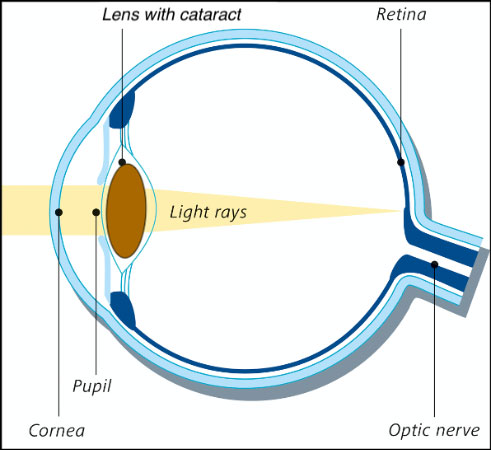Cataract – What is it? Benefits of cataract surgery and different lens options.
A cataract is a clouding or opacity of the crystalline lens inside your eye. The crystalline lens is the natural lens that sits in the eye, behind the coloured part of the eye (the iris). When cataract develops, the lens prevents light rays passing through or alters the pathway of these light rays, preventing objects that are in our sight from being focused sharply on the retina. This degrades the quality of vision and results in blurred vision.

What symptoms can cataract cause?
Cataracts usually develop gradually over years, causing a gradual reduction and blurring of vision, a reduction in the sharpness or a degradation in the overall quality of vision. Reading and generally fine work become increasingly difficult.
Glare may be noticed at night, even with early cataract; this can cause difficulty with driving at night-time. Other symptoms of cataract may include double vision in one eye, a ghosting effect, and the need for frequent change in spectacles.
A cataract does not cause pain or redness of the eye. However, if you are struggling to see clearly because of cataract and overusing your facial muscles in response, you may develop some headache over prolonged periods of detailed work.
Why do cataracts develop?
From the early years of our life there is natural decline in the elastic properties (elasticity) of the natural lens inside your eye. This results in the lens losing its ability to change shape (accommodate) and therefore focus at a range of distances. Once this causes difficulty or sluggishness in focusing for near objects, the condition is called dysfunctional lens syndrome or presbyopia; reading glasses start to be needed for reading and close-up activities in general.
Similar changes to your lens continue throughout life. Later in life the lens gradually develops an increasing brown hue and loses its transparency over many years and decades. The lens is described as a cataract when it has lost this transparency. As these changes usually develop very slowly, they are not noticed by patients until the cataract is removed and crisp vision is restored.
Other common causes for development of cataract, especially at a younger age, include metabolic disorders, such as diabetes, chronic steroid use such as prednisolone, trauma to the eye and previous eye surgery. Smoking and chronic exposure to sunlight have also been linked to the development of cataract.
How can a cataract be treated? With cataract surgery.
The only treatment for cataract is surgery. Cataract surgery is the most commonly performed operation with more than 400000 cases carried out in the United Kingdom per year.
You do not need to have surgery if you feel that your eyesight is not affected. However, it is essential that you remain safe and legal for driving; you must be able to see a standard number plate on a car from a distance of 20 metres. Your optician will be able to advise you regarding this.
A common myth is that cataracts need to be ‘ripe’ before considering surgery. This is not the case; cataracts can be operated upon once they are detected. Indeed, it is generally advisable not to let cataracts become too advanced as if they become dense the risks of surgery can be higher.
Most cataract operations nowadays are performed with the phacoemulsification technique. This involves the use of a small device to break up the lens and remove your cataract. It is performed through a small incision of only a few millimetres and doesn’t usually require any sutures. A new clear lens, called intraocular lens (IOL), is then placed in the position of your old lens; it focuses light rays sharply on the retina of your eye and remains in the eye for the rest of your life. The IOL is made of plastic materials or derivatives, such as PMMA and silicone.
What benefits can I expect following cataract surgery?
· Around 99% of patients have a significant improvement in vision following cataract surgery helping with driving, reading, working, hobbies, safety and self-confidence.
· Cataract surgery is also a refractive procedure; it provides a great opportunity to correct pre-existing and underlying refractive errors, such as astigmatism, short-sightedness and long-sightedness. It can therefore reduce the need for or the strength of glasses following the operation.
· In addition, cataract surgery provides the opportunity to reduce or eliminate the need for reading glasses. This is achieved with the use of multifocal IOL lenses, lenses that can focus your vision for distance, intermediate and near. These lenses are not available with NHS surgery.
· Co-existing eye conditions, such as macular degeneration or glaucoma, can limit the extent of improvement after surgery. However, if a significant cataract is present, cataract extraction surgery can provide a substantial improvement in the quality of your vision and life.
Are there any risks with cataract surgery?
As with all surgery, cataract surgery does have small risks. Overall, the risk of poorer vision is less than 1 in 200 cases. The more serious complications, such as infection, are rare and develop in less than 1 in 2000 cases. Potential complications that are usually temporary or easily treatable include raised pressure inside the eye, swelling of the retina (cystoid macular oedema), swelling of the cornea (corneal oedema) and postoperative inflammation. However, with appropriate selection the benefits of cataract surgery exceed the risks, as success rates and patient satisfaction rates are very high following the procedure.
What are my lens options for distance and near vision with surgery?
· As discussed above, removing your cataract is refractive surgery and this gives us the opportunity to address underlying refractive errors (need for glasses) and also refocus your vision for distance, near or both.
· In broad terms, IOL lens types and options include monofocal, multifocal and toric lenses.
· All patients undergoing cataract surgery have a lens (IOL) that is matched to their eye. The calculation of the power of this IOL is based on the eye measurements that are taken during your clinic visit. The power of the IOL will determine whether your natural vision (without glasses) is focused for distance, near or intermediate.
· Most patients prefer to have good distance vision without spectacles and the IOL power is selected accordingly. Spectacles however may still be needed following surgery for your best distance vision; this reflects technology limitations in predicting the IOL power that your eye may need. If you would rather not wear spectacles after your surgery, laser eye surgery may be considered after the cataract surgery as a top-up treatment in order to achieve your best distance vision without spectacles.
What is a monofocal lens?
· A monofocal lens, when used during your cataract surgery, will focus your vision for either distance (the most common choice) or near. As a result, spectacles will be required to provide you with the range of vision required for our daily activities.
· This is the lens type used during surgery on the NHS and is a good option for improving your vision in the presence of cataract.
· Monofocal lenses can be used to achieve monovision; this focuses your dominant eye for distance and your other eye for near, reducing your need for spectacles for near activities. Appropriate screening is required prior to cataract surgery to assess for suitability for monovision.
What are toric lenses?
Very often the cornea is not a perfect sphere in shape, resulting in astigmatism; a toric IOL can be used with cataract surgery to compensate for this astigmatism. A toric lens reduces or eliminates the need for spectacles after surgery, whether a monofocal or multifocal IOL has been used, and provides better quality vision. Detailed topography scans of the cornea are required to assess your suitability for a toric IOL.
What are multifocal lenses?
A multifocal lens is a great option if you are motivated and interested in being less dependent on spectacles following surgery. It can provide clear vision for both distance and near without glasses, allowing you to enjoy life with greater freedom. The majority of patients can read small print following surgery, however a weak pair of glasses may be needed for prolonged reading.
A multifocal lens can also be combined with astigmatism reduction by using a toric multifocal lens; this would allow you to achieve the best possible vision.
Multifocal lenses, however, are not suitable for everyone. If you have other eye conditions, such as age-related macular degeneration or corneal scarring, they would not provide you with good quality vision.
What about laser eye surgery?
Laser eye surgery can be carried out after cataract extraction if you are not happy with the outcome and require spectacles. It can sharpen up your vision so that you do not need your glasses.
PRESBYOND laser blended vision can also be performed so that you do not require spectacles for either distance or near. This is achieved by focusing your dominant eye for distance and your other eye for near.
What kind of anaesthetic is used for cataract surgery?
The vast majority of patients require local anaesthesia for cataract surgery. Local anaesthesia is applied either as eye drops or an injection around the eye. Once you have been given a local anaesthetic you will still be awake and aware of what is happening, but you will feel no pain during the operation. Very rarely, a general anaesthetic may be needed.
Local anaesthesia has fewer risks and side effects than a general anaesthetic. You will recover more quickly and can go home an hour or two after the operation.
How quick is the recovery after cataract surgery?
Your eye may be slightly scratchy the first few hours or night after surgery. You will be given antibiotic and anti-inflammatory drops to use to prevent infection and inflammation developing. These will also aid recovery.
Your vision will be blurred for the first 24-48 hours, due to the surgery and a large pupil. It will then start to improve. You may be able to drive within 3-4 days of surgery, as long as you can comfortably read a standard car number plate at 20 metres with both eyes open. At the same time, your eye must not be sensitive to light or uncomfortable in any way.
Consultation with Aris Konstantopoulos at ClarisVision.
At your clinic consultation Aris will examine your eyes in order to assess your need and suitability for cataract surgery. In addition to your eye health, Aris will also take into consideration other factors, such as your age, your lifestyle, overall health and the desired outcome, so that he can advise the most suitable procedure and lens option.
Please complete the form on our contact page or call 02381 812281 to book a consultation or a free no obligation screening visit.



